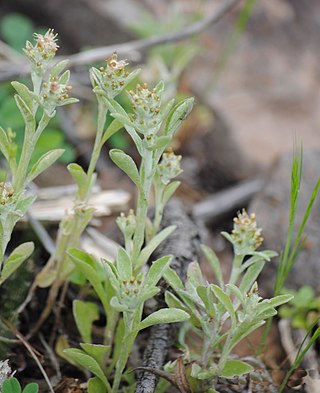Isocarpha (pearlhead) is a genus of flowering plants in the family Asteraceae. They are native to Mexico, Central America, the West Indies, and northern South America, with the range of one species extending north into the United States.
Tetraneuris scaposa is a North American species of flowering plant in the sunflower family. It is native to the southwestern and south-central United States and northern Mexico.

Helianthus angustifolius is a species of sunflower known by the common name narrowleaf sunflower or swamp sunflower. It is native to the south-central and eastern United States, found in all the coastal states from Texas to Long Island, and inland as far as Missouri. It is typically found in the coastal plain habitat, particularly in wet areas.
Flyriella parryi, the Chisos Mountain brickellbush, is a Mexican species of plants in the family Asteraceae. It is native to the states of Nuevo León, Coahuila, and Chihuahua in northern Mexico. It is the only species in its genus to have a natural range extending north of the international border, with a few populations on the Texas side of the Río Grande.
Gaillardia coahuilensis, the bandanna daisy, is a North American species of flowering plant in the sunflower family. It is native to northwestern Mexico (Coahuila) and the southwestern United States.

Gaillardia suavis is a species of flowering plant in the sunflower family, common names pincushion daisy and perfumeballs. It is native to northern Mexico and the southern Great Plains of the United States.

Gamochaeta coarctata, the gray everlasting, is a species of flowering plant in the family Asteraceae. It is widespread in South America and naturalized in parts of Eurasia, Australia, and North America.

Gamochaeta pensylvanica, the Pennsylvania cudweed or Pennsylvania everlasting, is a widespread species of flowering plant in the family Asteraceae. It is native to South America and introduced into Eurasia, Africa, Australia, and North America. The pensylvanica epithet is a misnomer, as the plant is not native to Pennsylvania and only marginally naturalized there.
Grindelia havardii, or Havard's gumweed, is a North American species of flowering plants in the family Asteraceae. It is native to the south-central United States, in the states of Texas and New Mexico.
Grindelia oxylepis, the Mexican gumweed, is a North American species of flowering plants in the family Asteraceae. It is native to northern Mexico, in the States of Chihuahua, Coahuila, Durango, San Luis Potosí, and Zacatecas. The natural range barely crosses the Río Grande into the United States, with a few populations in western Texas and southern New Mexico
Gundlachia triantha, the TransPecos goldenshrub or Trans-Pecos desert goldenrod, is a North American species of plants in the sunflower family. It is native to northern Mexico, with the range extending just over the Río Grande into western Texas in and near Big Bend National Park.

Helianthella quinquenervis, the fivenerve helianthella, is a North American plant species in the family Asteraceae. It grows in the mountains of the western United States and northern Mexico. This include the Rockies, the Black Hills, the ranges of the Great Basin, and the northern Sierra Madre, from Montana, Oregon, and South Dakota south as far as western Chihuahua and Coahuila.

Hieracium longipilum, the hairy hawkweed, is a North American plant species in the tribe Cichorieae within the family Asteraceae. It is widespread across much of central Canada and the central United States from Ontario south to Texas and Louisiana. There are old reports of the species growing in Québec, but apparently does not grow there now.

Hymenopappus artemisiifolius, the oldplainsman, is a North American species of flowering plant in the daisy family. It has been found only in the south-central United States, in Texas, Arkansas, and Louisiana. Its natural habitat is in sandy soils of prairies and open woodlands.

Hymenopappus scabiosaeus, the Carolina woollywhite, is a North American species of flowering plant in the daisy family. It grows in the central and southeastern United States, primarily on the Great Plains an on the Coastal Plain of the Southeast. There are also isolated populations in Illinois and Indiana as well as in the state of Coahuila in northern Mexico.
Tetraneuris linearifolia is a North American species of plants in the sunflower family, known by the common name fineleaf fournerved daisy. It grows in the south-central United States and northern Mexico.
Isocarpha atriplicifolia is a New World species of plants in the family Asteraceae. It is widely distributed in southern Mexico, Central America, the West Indies, and northern South America.
Isocarpha megacephala is a New World species of plants in the family Asteraceae. It has been found only in northeastern Brazil.
Isocarpha microcephala is a New World species of plants in the family Asteraceae. It has been found only in Perú and Ecuador.
Isocarpha fistulosa is a New World species of plants in the family Asteraceae. It has been found only in Perú and Ecuador.







